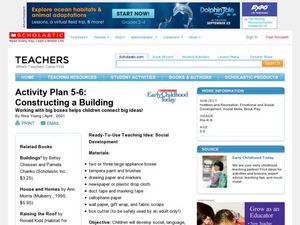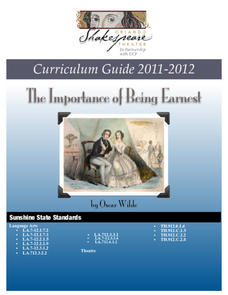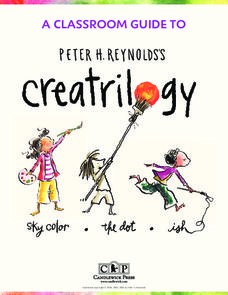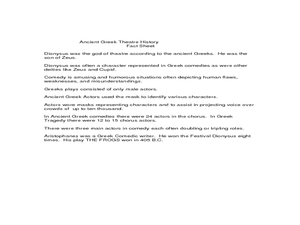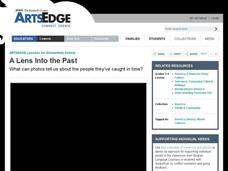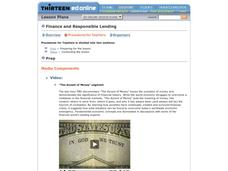Curated OER
Constructing a Building
Students work with big boxes to connect big ideas. In this early childhood problem solving instructional activity, students develop social, language, math, creative-thinking, and problem-solving skills as they work together to plan and...
Curated OER
Higglytown Heroes Study Guide
Students view the program and participate in various activities. They observe and participate in activities designed to introduce them to such issues as problem solving and community roles. In addition, they complete various art ...
Orlando Shakes
The Importance of Being Earnest: Study Guide
Historically, members of the upper class provide plenty of fodder for comedic writers. Oscar Wilde's The Importance of Being Earnest is no exception, and a study guide for the classic play discusses some of the Victorian social...
Curated OER
Using Words to Work Things Out
Students explore appropriate ways to communicate feelings. In this character development lesson, students listen to Hands are not for Hitting and several other books about expressing emotions appropriately. Students observe...
Curated OER
Think Fast! What Would You Do If . . .
Fifth graders use critical thinking and problem solving skills. It allows students to make choices and to use imagination to develop a solution for each problem. Solutions are then presented to the class.
Curated OER
Advanced Art – Cultural Place-setting Still life
Upper graders view a series of films that depict rituals or celebrations as they occur in different cultural settings. They conduct a cultural investigation about one culture, brainstorm and research objects that have cultural or...
Curated OER
A Day in the Life of a Homeless Person
Learners examine the day in the life of a homeless person. In this humanitarian lesson, students examine the life of a homeless person while discovering the importance of social justice in our society.
Candlewick Press
A Classroom Guide to Peter H. Reynolds's Creatrilogy
Help young readers find, identify, and use their voices with a set of empowering activities based on Peter H. Reynolds' trilogy of books. Sky Color, Ish, and The Dot focus on recognizing moods and treating each other...
Curated OER
Totem Mask
Sixth graders study totems of the Northwest Native Americans and design their own.
Curated OER
Making Good Decisions
Students examine the "Little Planet Times" and discuss how to solve the town's problem. For this literature/problem solving lesson, students record the opinion of each of the council members and role play their position. Students...
Curated OER
Dancing with Dionysus
Sixth graders research Ancient Greek culture by acting in a play for the festival of Dionysus. In this Greek culture activity, 6th graders study an ancient Greek map and the Sarcophagus Dionysus from the Walters Art Museum website....
Curated OER
School Redesign and Multiple Intelligences
Students examine their own intelligence to find areas of strength after studying the multiple intelligences. In this diverse learning styles lesson plan, students analyze how the school environment fosters or fails students of...
Curated OER
Architecture
Students study tessellations and the work of M.C. Escher. They discuss the terminology of architecture, the historical significance of architecture in different parts of the world, and create their own piece of architecture out of...
Curated OER
1,000 Cranes
Learners improve motor skills through careful folding, a discipline necessary in the practice of origami. They develop multicultural awareness by exploring Japanese history.
Curated OER
A Lens into the Past
Explore the history of immigration through photographs. Scholars will view and discuss photographs depicting the culture and lifestyle of late 19th and early 20th century immigrants. They take pictures of current examples of culture in...
Curated OER
Finance and Responsible Lending
Learners learn the characteristics of economic systems through problem solving, communication and representation. In this financial lending lesson, students use math to solve problems dealing with the economy today, to work with their...
Curated OER
Dream Catchers
Students create Native American dream catchers to represent the Native American culture. After reading and discussing the origin of the Dream cather, they begin to construct their dream catchers using wire hoops, thread, beads, and...
Curated OER
Masks of Many Cultures: Celebrations of Life
Bring art and society together with this highly creative and interesting lesson. Learners research various uses of masks in ceremonies. They then create a ceremony of their own and a mask to go along with it. They film themselves...
Digital Forsyth
Restoration Project
In need of a neat idea that incorporates technology skills, art, and history? Young art historians will each select an old photograph from a local archive to digitally restore. The primary focus is to add color, clarity, and remake the...
Curated OER
Window Skills: Make Your Own Wallpaper
Students create wallpaper for their computer screen. In this technology lesson, students use KidPix or Paint to design a picture which will be used as the wallpaper on their computer.
Curated OER
Take a Leap!
Eighth graders discuss the flight of the Wright Brothers at Kitty Hawk. They study artwork of various sculptors showing the concept of flight. They write a paragraph and design a papier-mache' sculpture that shows movement.
Curated OER
Earth Day: a Look Into the World Around Us
Young scholars develop an artwork made entirely out of recycled materials to exhibit during an Earth Day celebration. They participate in a lecture discussion on the history of Earth Day and environmental issues, do internet research on...
Curated OER
Pirate Map
Students write directions explaining how to get from one location to another by using a map of their town and use simple maps to identify and locate places.
Curated OER
A Different Point of View
Fourth graders imagine what North Carolina looks like from the air. Looking at a map, they list the different kinds of views we might find, (i.e., beach, mountains, cities, farms, etc.) then attempt to draw their own version of a map.
